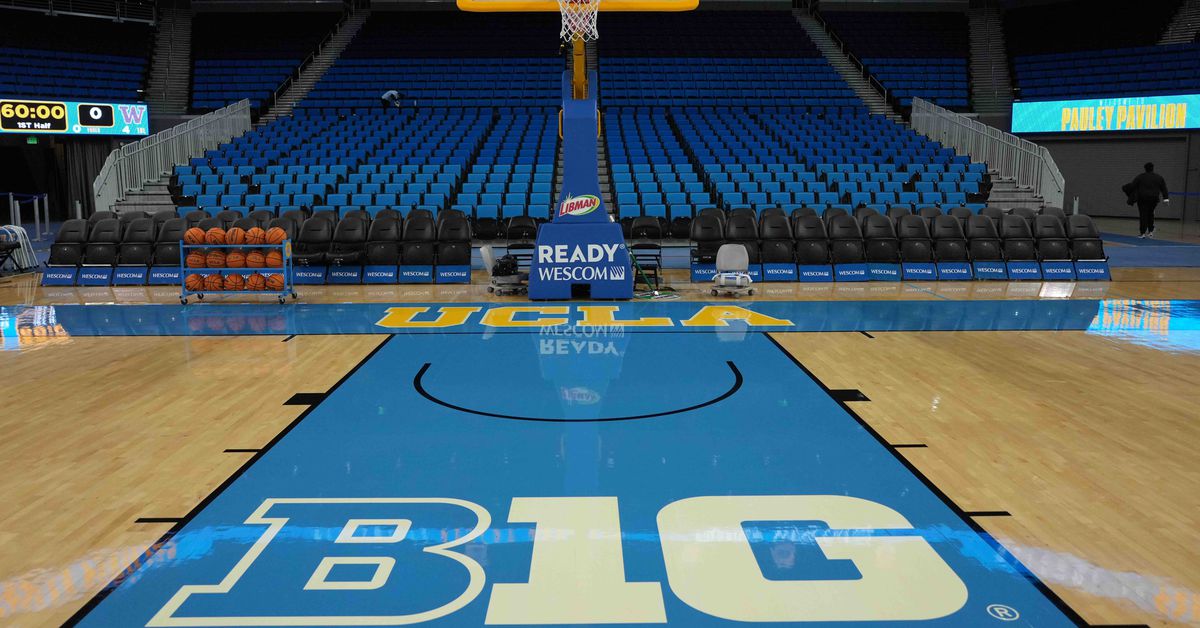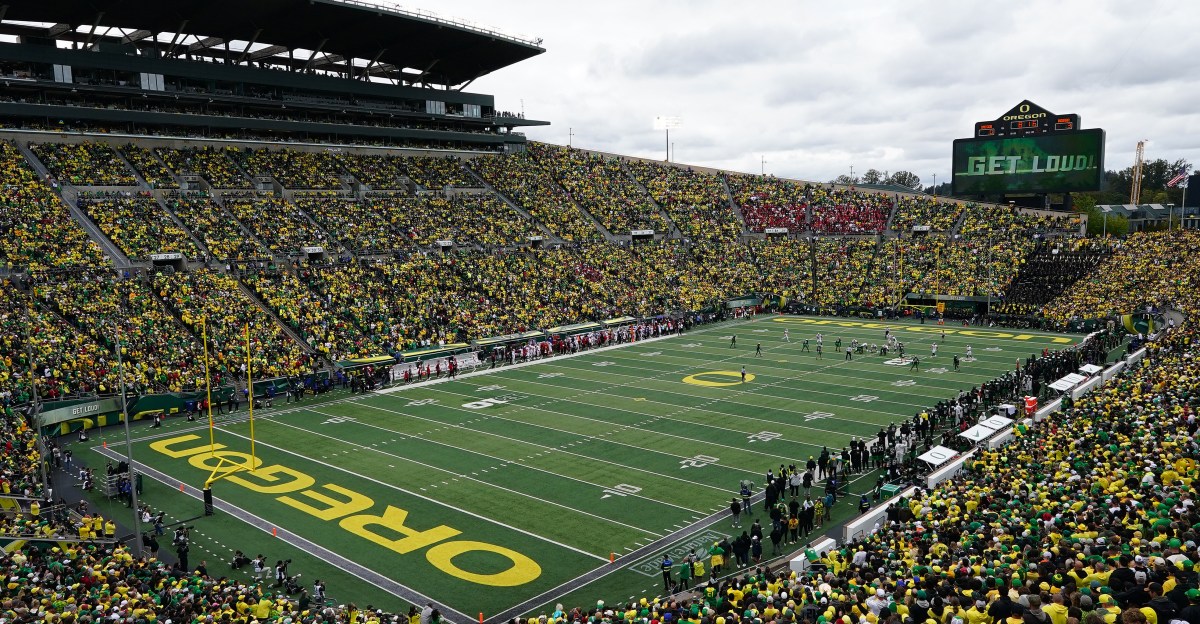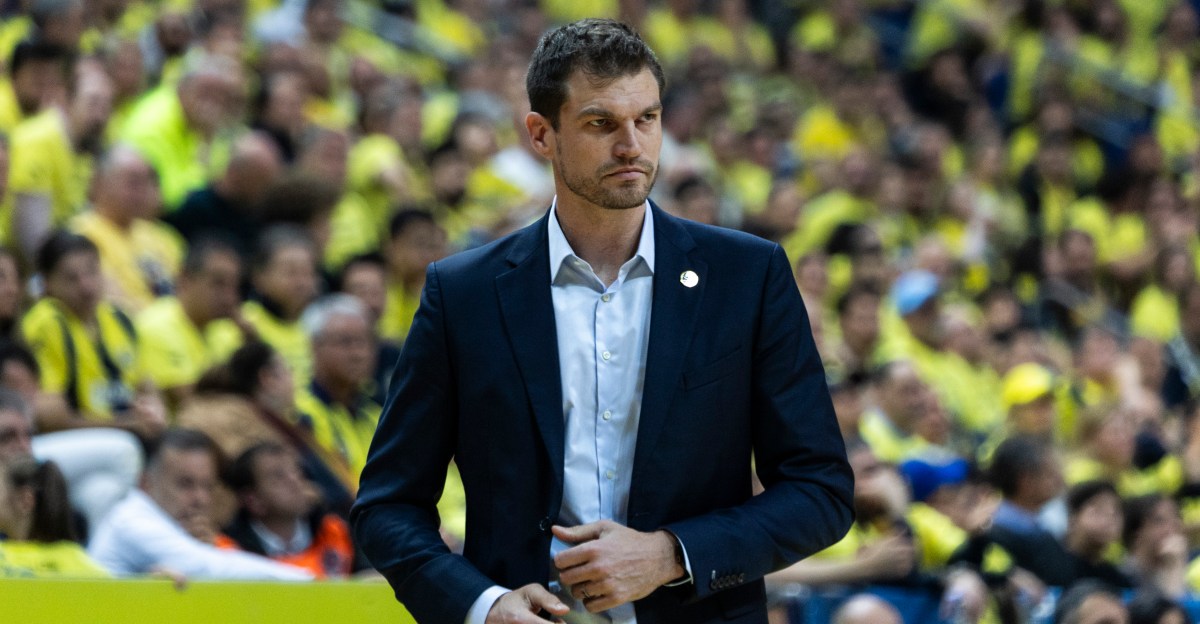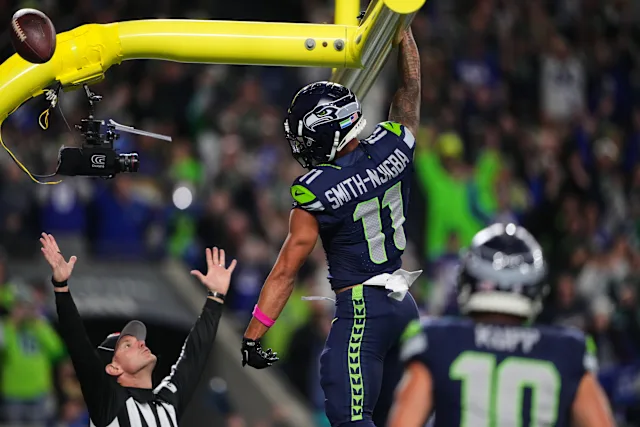Oregon Ducks MBB: The B1G Men’s Skyscraper
We now turn our attention to the skyscraper juggernaut known as the B!G Men’s Skyscraper. Here we have grouped the B1G men’s basketball teams into three tiers – Penthouse Level, Executive Level, and Business Level. The parsing is how I subjectively view the rankings, and I’m basing where I’m placing teams based primarily on ranking, overall record, and NET ranking.
This isn’t hard and fast; as I say, there’s subjectivity involved, and there’s considerable fluidity going forward – there’s a lot of basketball to be played, folks.
Now that we’re about midway into the season, let’s take a look at B1G men’s basketball and see how the teams are stacking up.
Here are how the teams were ranked in the preseason media poll:
- 1. Purdue (20 first-place votes)
- 2. Indiana (7)
- 3. UCLA (2)
- 4. Illinois (2)
- 5. Michigan State (1)
- 6. Oregon
- 7. Rutgers
- 8. Ohio State (1)
- 9. Michigan
- 10. Maryland
- 11. Iowa
- T-12. Nebraska
- T-12. Wisconsin
- 14. USC
- 15. Washington
- 16. Northwestern
- 17. Penn State
- 18. Minnesota
The rankings below and NET reflect the standings at the beginning of this week. Everyone’s record (and conference standing) is up to date as of Thursday, 1/16 (unless I overlooked something, of course).
PENTHOUSE LEVEL
#12 Michigan State 15-2 (6-0 Big-10)
NET 10
The Spartans have been doing good things, and while I might hope that fans are satisfied, that fact is that I don’t really know. Michigan State has had no problems with the competition, even as they have not exactly played against rated teams.
This is not a knock. The Spartans have done what they’ve needed to do. Their losses are against Kansas and Memphis, and this is not alarming to me.
Michigan State is a team that does well shooting in the field (48%), even as they are not so hot from distance (29%). They have only one player that averages in double-digit scoring this season, 6-4 G Jaden Akins with 14.2 PPG.
This is a team that distributes and protects the ball well, with a 3-2 assist-to-turnover ratio. There’s a lot of teams out there that wish they had that profile.
Michigan State is doing their Spartan thing. They were a preseason #5 in the conference. I think they will do better, and they certainly deserve their spot in the Penthouse.
The Spartans’ next four games are against Illinois, Rutgers, Minnesota, and USC.
#13 Oregon 15-2 (4-2 Big-10)
NET 21
I really don’t know what to think about the Ducks, even as they are the team that I follow. In the past couple of seasons, Oregon has been dealing with huge injury issues, and has had to really fight for a place in the postseason. This year they’re healthy, and it shows.
The Ducks scheduled the non-conference portion of the season aggressively. That has paid off, with wins over #11 Texas A&M and #4 Alabama.
Their losses have been conference losses. They lost to a mid-level UCLA team, and you could attribute that to a lucky Trojan bucket that beat the buzzer. Fine. To lose 109-77 to Illinois is a possible red flag. The other B1G opponents have been Business Level competition.
7-0 C Nate Bittle is driving this team, and leads with 13.7 PPG. Other players in double digits are Jackson Shelstad with 12.5 PPG and Keeshawn Barthelemy with 10.1 PPG. The Ducks have a 1.34/1 assist-to-turnover ratio, so they move the ball well.
This team is deep and healthy, and it’s difficult to project how they’ll end up. They have had some squeakers against lesser competition, and that’s troubling.
Oregon has a B1G match against Purdue on Saturday. That match should give us an idea of who these teams are. After that, Oregon faces Washington, Minnesota, and UCLA.
#17 Purdue 14-4 (6-1 Big-10)
NET 15
The Boilermakers are an enigma. They have wins against ranked teams like Alabama and Ole Miss. They have ranked losses against Texas A&M and Marquette.
Then they lose in the early conference season to Penn State. While that may seem uncomfortable, nearly all of the Penthouse Level teams have a loss that they’d like to have back.
As a team, Purdue is shooting well – nearly 50% from the field, 39% on the long ball. They have three players shooting 14.1 PPG or more, led by 6-9 F Trey Kaufman-Renn with 17.6 PPG. Purdue has an assist-to-turnover rate of about 1.6/1.
Purdue will next face Oregon, Ohio State, Michigan, and Indiana.
#19 Illinois 13-4 (5-2 Big-10)
NET 7
The Fighting Illini have lost to #4 Alabama and #6 Tennessee. They have won against #13 Oregon, and their most recent win was against Indiana. Their B1G losses were against Northwestern and USC.
Illinois has five players in double-digit PPG, led by 6-6 G Kasparas Jakucionis with 16.7 PPG. They shoot well and have a 1.3/1 assist-to-turnover ratio. That NET rating is the highest of any team in the B1G. The Illini should remain in the Penthouse level, provided they keep their record up and don’t drop games that they should win.
The Illini next play against Michigan State, Maryland, Northwestern, and Nebraska.
#20 Michigan 13-4 (5-1, Big-10)
NET 10
The Wolverines had been playing well. They had wins against teams earlier this season that were ranked at the time, but now are not. They defeated Wisconsin last month, and that’s still a good win.
Then, on Thursday, they threw up on their shoes and lost to last-place Minnesota. Not a great look. However, Michigan has four losses by a combined 8 points.
The Wolverines have five players in double digits, led by 7-1 C Vladislave Goldin with 15.5 PPG. They shoot very well at over 51%, and 38% from distance. Their assist-to-turnover ratio is 1.23/1.
Michigan is a team that has the firepower to stay in the Penthouse…just don’t throw up on your shoes again. One unfortunate loss will not break their season.
The Wolverines next face Northwestern, Purdue, Penn State, and Rutgers.
#24 Wisconsin 14-3 (4-2, Big-10)
NET 24
The Badgers had three losses in a row in December, to Michigan, #7 Marquette, and #19 Illinois. They don’t have wins over ranked opposition as of yet, but they get their opportunity to show who they are at the end of the regular season. They’ll be up against ranked teams in four of their last five games of the season: Purdue, Illinois, Oregon, and Michigan State. That’s going to be one heck of a gauntlet to close the season.
Wisconsin is shooting 46% from the field (35% from distance), and has five players scoring double-digit PPG, led by 6-5 G John Tonje with 18.2 PPG.
The Badgers will be facing USC, UCLA, Nebraska, and Maryland in the next couple of weeks.
My feeling is that the team that is in the most precarious position in the Penthouse Level is Oregon. That said, the Penthouse Level has no clear-cut leaders, and any of these teams are capable of defeating each other on any given day.
EXECUTIVE LEVEL
Indiana 13-5 (4-3, Big-10)
NET 63
The Hoosiers inadvertently didn’t challenge themselves in the non-conference part of the season, and it wasn’t for a lack of scheduling. They had losses to Louisville (currently ranked #30) and #16 Gonzaga, and I’m pretty sure very few projected those kinds of rankings for those two teams at this point in the season.
What is hurting Indiana right now is that they have fallen off a balcony at the Executive Level. By that, I mean they lost last weekend to Iowa and Illinois by 25 points. Not combined, mind you – they lost each game by 25 points.
In the seven conference games they’ve played, the Hoosiers are being outscored from the field 47% to 42%, including 30.5% to 31.5% on the long ball. Their overall rebound numbers are superior, even as they had problems on the glass the past two games. Their assist-to-turnover ratio is 1.41/1 in conference play, so they are moving the ball well.
They have four players scoring in the double digits, led by 7-0 C Oumar Ballo with 14.1 PPG. (It should be noted that there’s a drop across the board when we look at conference stats).
Indiana has fallen off the balcony, but they have a tenuous grip on the edge. They can pull themselves up, but will they? Their next three games are against OSU, Northwestern, and Maryland. Those are all winnable games, and games that the Hoosiers must win if they want to stay on the Executive Level – much less move up to the Penthouse.
Maryland 13-5 (3-4, Big-10)
NET 23
Maryland’s losses have mostly been at the hands of ranked teams – Marquette, Purdue, Oregon – but they have also lost to Washington, and their most recent OT loss to Northwestern.
The Terps are shooting 49% (36% from distance), and have their five starters shooting double digits, led by 6-10 C Derik Queen. Their assist-to-turnover ratio has been 1.46/1.
Maryland’s conference shooting dips in conference play, but not precipitously. The A/TO ratio does drop to nearly 1/1. The most glaring stat is that opponents are out-rebounding the Terps 33.1 RPG to 32.6 RPG.
Maryland still has two or three ranked opponents left on their schedule, and will be slogging it out to hold their place in the middle of the B1G rankings. Their next four matches pit them against Nebraska, Illinois, Indiana, and Wisconsin.
Iowa 12-5 (3-3, Big-10)
NET 48
Iowa did not play a particularly challenging non-conference schedule when it came to teams that were not ranked, but they sure tried to make up for it against ranked teams. Alas, they lost to #2 Iowa State and #22 Utah State. In conference, they have lost to the ranked teams they faced (Michigan, Wisconsin), but also dropped their most recent contest against USC.
The Hawkeyes have been shooting well from the field at 51% (39.8% from distance). They only drop to 50% in conference play, but improve the 3-pointers to 42%! All four of their best shooters, led by 6-8 F Payton Sandfort, have improved their PPG shooting in-conference. They have a great assist-to-turnover ratio at 1.71/1 – in conference play! (1.9/1 cumulative). So what’s the problem here?
First, Iowa does not shoot particularly well at the line. They survived shooting 68.6% overall because the opposition was shooting 65.5%. In- conference, however, their opponents are shooting 70% to 68%.
Second, the Hawks can’t seem to rebound a ball to save their life. They are getting crashed at the boards 38.1 RPG to 33.1 RPG overall, and 37.8 RPG to 28.3 RPG in-conference.
Finally, Iowa hasn’t been good on the road, going 10-1 at home and 0-3 away from home. The road woes have come because of the aforementioned rebounding, but poor defense has been a huge contributing factor. Opposing teams are shooting crazy percentages because they’re not being defended very well.
The Hawkeyes are another mid-level team that is in danger of falling off the balcony, but they have the talent to fix things – they just don’t have any time to waste.
Iowa next faces Minnesota, Penn State, Ohio State, and Purdue.
Nebraska 12-5 (2-4, Big-10)
NET 45
The Cornhuskers played a weak non-conference schedule, and their only loss was against a St. Mary’s squad that’s currently ranked #37 with 3 votes. They lost in December to Michigan State, and the shine on a win over a UCLA team that was ranked #15 at the time has terminally oxidized as the Bruins fade into mediocrity.
Nebraska has lost their last three games in a row, including a loss against Rutgers that broke their 20-game home win streak.
It seems fair to say that Nebraska is not panicking the way that some other teams in the B1G are. They’ve competed, and know that they have some details to fix.
The Huskers are shooting 46% (33.8 from distance), and 75% from the line. They have three players averaging double digits per game, led by 6-7 G Brice Williams with 18.9 PPG. They have an AST/TO ratio of 1.13/1. While Nebraska has the edge in rebounds, opponents are pulling in more offensive rebounds than the Huskers.
Up next for Nebraska is contests against Maryland and USC. After that is a gauntlet of ranked teams, where they face Wisconsin, Illinois, and Oregon.
USC 11-6 (3-3, Big-10)
NET 73
The Trojans have been a bit of a mixed bag. They didn’t play anyone noteworthy in the offseason, and lost to California, St. Mary’s, and New Mexico. In conference play, they lost to Oregon, Michigan, and Indiana, but did pick up a ranked win last weekend against Illinois.
USC is shooting well at 48% from the field, 35% from distance, and 74% at the line. They have a 1.4/1 AST/TO ratio.
This is a team with talent, so what is going on, especially in the early part of the season? The departure of previous coach Andy Enfield to SMU set off the dominos of departures, and new coach Eric Musselman had to essentially build a new roster, bringing in 11 players from the transfer portal.
What this translates into is a lot of players that aren’t used to playing together, and it shows in some of the ball control stats. In conference play, USC is turning the ball over more than their opponents and has fewer steals per game.
The Trojans are not without talent, and they’re showing signs of playing more cohesively, so we’ll just have to wait and see how it goes. Their games in the next two weeks include Wisconsin, Nebraska, UCLA, and Michigan State.
UCLA 11-6 (2-4 Big-10)
NET 38
On paper, the Bruins had a respectable non-conference slate that should have meant more than it does. The same New Mexico that defeated USC also defeated UCLA and owns Los Angeles, I guess. Then UCLA picks up a win against #16 Gonzaga, but wins against an unranked (!) Arizona team, and loses against unranked North Carolina. (It must be 2025).
The Bruins got a ranked win over Oregon in a 3-point buzzer beater, but lost four in a row to Nebraska, Michigan, Maryland, and Rutgers.
“I think we are trying, but here are the facts. We have struggled in Big Ten basketball. Our two wins were against teams we were familiar playing against. The truth of it is, Big Ten basketball is different. It’s a much more physical game.”
Coach Cronin, speaking on Thursday pic.twitter.com/1Pw3pB0oXc
— UCLA Men’s Basketball (@UCLAMBB) January 16, 2025
UCLA needs to figure out its program quickly. In conference play, they are being outscored in the field and the FT line, out-rebounded, out-blocked, and have fewer steals.
The Bruins have three players in double digits, led by 6-9 F Tyler Bilodueu with 13.2 PPG (in conference play).
The next four games for the Bruins include a couple of ranked teams in Wisconsin and Oregon, as well as unranked Washington and USC.
The Executive Level is fairly dynamic, and there are teams capable of going up or down. Like the Penthouse Level, these are teams can defeat any others here, and I think we’ll see a different look six weeks from now.
BUSINESS LEVEL
Northwestern 11-8 (2-4, Big-10)
NET 56
The Wildcats did not play any ranked teams in their non-conference schedule. Their losses were to Dayton and Butler. In conference play, they pulled out an impressive win on the road against Illinois. This month, the Wildcats suffered a 3-game losing streak to Penn State, Purdue, and Michigan State, then followed it with an important win against Maryland.
Conference play statistics are more revealing than cumulative stats, and shows a NW team that struggles to score. They average 42.5% from the field (opponents shoot 46%) and struggle from beyond the arc, shooting 27.1% (opponents shoot 33.3%). The Wildcats hold their own in most every other category.
Their top three scorers shoot in the double digits, starting at 11.5 PPG, led by 6-7 F Nick Martinelli with 20.5 PPG. After those three, scoring goes into a death spin; the next three scorers only contribute 5.0 to 7.0 PPG, and after that you have six players shooting 3.7 PPG and under.
While Northwestern shows the ability to play spoiler to teams in the Executive Level, they are solidly in the bottom tier of the B1G and probably will remain that way.
Penn State 12-6 (2-5, Big-10)
NET 49
The Nittany Lions did not have much to roar about in the non-conference portion of their season. They suffered a loss against Clemson, but the rest of their wins were not particularly noteworthy.
In December, Penn State pulled off a stunning win against Purdue in a convincing 81-70 victory. They currently are on a four-game skid, but that’s because of the nature of the competition; having lost to Indiana, Illinois, Oregon, and Michigan State.
Penn State has cleverly made the button to get Big-10 stats send you to the season schedule, so I don’t have any conference stat information (which I consider to be more informative than cumulative stats in this case).
The Lions have six players that are scoring in double digits, led by 6-1 G Ace Baldwin, Jr. with 14.2 PPG. After those six, however, points production plunges over the cliff, and I have no reason to believe that conference play reveals differently.
Penn State has suffered a significant blow with the loss of Puff Johnson to a right-hand injury that will keep him off the court for awhile. Johnson has been averaging 10.1 PPG and the Lions really have no one to replace his production.
Penn State’s next four games are against Rutgers, Iowa, Michigan, and Ohio State.
Ohio State 10-8 (2-5, Big-10)
NET 31
The Buckeyes scheduled relatively aggressively in their non-conference slate. They opened their season with a win against Texas, which was ranked at the time but is no longer. OSU did pull of a 20-point win against #8 Kentucky in December, and they lost to #11 Texas A&M, #1 Auburn, and unranked Pitt.
Conference play has been less kind to OSU. They have dropped four of their last five conference games to Michigan State, Oregon, Wisconsin, and Indiana, with their sole win coming against Minnesota.
The Buckeyes have four players scoring in double digits in conference play, led by 6-2 G Bruce Thornton with 16.9 PPG.
As with all teams at this level, the conference stats shed some light on why OSU is struggling in a way cumulative stats may not. As a team, they Buckeyes are being outscored by their opponents 43.3% to 43.6% – 30% to 31% on threes – as well as 3 PPG. They are also being slightly out-rebounded to the tune of 1 RPG.
The reason why I list assist to turnover ratios is that it paints a picture of what kind of ball control a team has – or doesn’t have, as it were. In the case of the Buckeyes, they are sporting an AST/TO ratio of .8/1, which is pretty abysmal. This team has ball control issues.
That said, the Buckeyes really are on the bubble of being an Executive Level team. If they can clean up their game, they can rise in the rankings. Play as they have been, however, and they are destined to be at the bottom.
OSU’s next four games are against Purdue, Iowa, Penn State, and Illinois. They really need 3 of these 4 games to be competitive in B1G play.
Rutgers 10-8 (3-4, Big-10)
NET 86
The Scarlet Knights scheduled their non-conference portion more aggressively than many others; they just couldn’t strike paydirt with it. Yes, they had losses against #4 Alabama and Texas A&M, but they also dropped contests against St. John’s, Kennesaw State, and Princeton.
Their conference losses have been against Ohio State, Indiana, Wisconsin, and Purdue. They are currently on a 2-game winning streak, including the win at Nebraska that I spoke of.
In conference play, Rutgers is shooting 42.4% against 46.8% from opponents. From beyond the arc, they shoot 33% to the opposition’s 34%. They are not a very good FT shooting team, and only sink 63.6% of their free throws. The Knights have an underwhelming scoring production, as they only have two players scoring the double digits: 6-10 F Ace Bailey with 19.4 PPG, and 5-5 G Dylan Harper with 14.8 PPG. The rest of the team is 6.6 PPG and under.
Rutgers has a nearly 1/1 AST/TO ratio; however, opponents are getting about four more assists per game and the Knights are turning the ball over 2.3 more times per game. Opponents are also out-stealing Rutgers.
The lack of offensive production for the Scarlet Knights is translating to Rutgers scoring about 6 less PPG than their opponents.
Rutgers finishes their season with a nearly equal mix of ranked and unranked teams. Whomever set the B1G schedule this year did Rutgers no favors – they have arguably the toughest conference schedule in the league. Their next four games are against Penn State, Michigan State, Northwestern, and Michigan.
Washington 10-8 (1-6, Big-10)
NET 95
The Huskies have picked up nearly all of their wins by playing easy opponents in the non-conference slate, and no one of note. Their sole out-of-conference loss was against Nevada in November.
Their single conference win has been against Maryland. Their losses have been in the double digits except for a four-point loss against Illinois, and the Huskies are on a four-game losing streak.
Conference stats show that Washington is pretty horrible at defense; opponents are shooting 50% from the field against them. The Huskies are also being out-rebounded by 2.3 RPG.
Their AST/TO ratio is .91/1, and while they are winning the turnover battle, opponents have the upper hand in steals.
Washington has three players scoring in the double digits, led by 6-8 F Great Osbor with 15.6 PPG. Their top seven players aren’t the worst of the teams in the Business Level when it comes to scoring…it’s just that the Huskies are not defending well. That’s going to keep Washington in the bottom of the B1G standings.
Next up, the Huskies face Oregon, UCLA, Minnesota, and Nebraska.
Minnesota 9-9 (1-6 Big-10)
NET 157
The Golden Gophers’ non-conference schedule was exactly as you might suspect, given their record, except they played no one at all that was noteworthy (as reflected in the NET ranking). A few teams were completely new names to me, but it’s not like I’m an expert. Far from it. Their losses were against North Texas, Wichita State, and Wake Forest.
Minnesota was on a six-game B1G losing streak before stunning Michigan with a 84-81 OT win at home on Thursday. Huge upset – it cannot be overstated – and good for the Gophers for pulling it off.
Minnesota is not providing conference stats, so I don’t have much to impart to you. They have three players scoring in double digits, led by 6-11 F Dawson Garcia with 19.1 PPG. After those three, there is not much offensive production; no real help from the other starters and no bench to speak of. Also, with a FT percentage of 63.5%, the Gophers are pretty bad at the line.
Their next four games are against Iowa, Oregon, Michigan State, and Washington.
:no_upscale()/cdn.vox-cdn.com/uploads/chorus_asset/file/25836359/usa_today_25175154.jpg)
Matthew O’Haren-Imagn Images
You may have noticed that I dug into the lesser teams more than those in the Penthouse Level. That is because we know that the ranked teams are good and there’s little separation between them. The reason why I dig deeper into the other teams is that it’s fascinating to me why they are failing, if you will, or why they are downright bad. I’m not kicking these teams while they’re down; instead, I try to look into what it is in their play that causes them to be ranked where they are.
In summary, it looks like anyone’s game of the teams in the Penthouse Level, but we’ll probably see two or three distance themselves from the rest. I have no idea who that might be, and we’ll know more a month from now.
The Executive Level is a free-for-all. There may be teams that rise or fall to other levels, but the matches here will be compelling and it will be interesting to see who can go on a run to end the season.
Minnesota, Washington, and Penn State are probably stuck in the Business Level. The others have a chance to move up IF they can clean up their game, and I think Ohio State is the team most likely to rise.
Regardless, we’re in for some great basketball headed toward the Big Ten tournament.
Share this content:















Post Comment